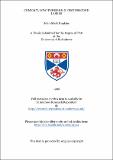Files in this item
Compact, low-threshold femtosecond lasers
Item metadata
| dc.contributor.advisor | Sibbett, Wilson | |
| dc.contributor.author | Hopkins, John-Mark | |
| dc.coverage.spatial | 245 p. | en_US |
| dc.date.accessioned | 2018-06-20T10:32:27Z | |
| dc.date.available | 2018-06-20T10:32:27Z | |
| dc.date.issued | 1999-05 | |
| dc.identifier.uri | https://hdl.handle.net/10023/14314 | |
| dc.description.abstract | This thesis is concerned with the design and development of compact, all-solid-state femtosecond pulse lasers with low pump power requirements. A number of directly-diode- pumped laser systems based on the gain materials Cr3:LiSrGaF6 (chromium-doped lithium strontium aluminium fluoride) and Cr3:LiSrGaF6 (chromium-doped lithium strontium gallium fluoride) pumped with AlGaInP laser diodes are described. The motivation behind this work was the development of portable, low-noise and lower cost ultrashort pulse lasers for a number of low-power applications such as the characterisation of electron-optical streak camera systems. The investigation into the modelocking of lasers with modest intracavity powers was also an important challenge. The achievement of a battery-powered, compact and efficient laser system represents an excellent outcome for this research programme. Major consideration is given to the key factors that determine both the cw and modelocking thresholds of an ultrashort-pulse laser. In particular, the reduction of intracavity optical losses by designing the laser to operate with fewer cavity elements, the optimisation of second-order and higher-order dispersion for efficient modelocked operation and the inclusion of a semiconductor saturable absorber mirror for increased stability are discussed. This has enabled pump thresholds to be reduced to a level permitting, for the first time, the use of diffraction-limited, narrow-stripe laser diodes for efficient, low-power optical pumping. A number of laser oscillators with novel cavity designs and progressively lower pump thresholds are described. Pulses as short as 57 fs and average output powers as high as 9 mW for only 80 mW of incident pump power are reported for a battery powered femtosecond Cr:LiSAF laser. This represents an overall electrical-to-optical conversion efficiency of approximately 1% which is excellent for a femtosecond pulse laser system. In addition, the amplitude and phase noise performance is shown to be exceptionally good and is believed to be the best yet reported for this type of ultrashort pulse laser. The design and demonstration of highly compact, ultrashort-pulse lasers incorporating novel resonator configurations and simplified dispersion compensation schemes are then described. These lasers produced sub-ps pulses at cavity frequencies as high as 450 MHz. | en_US |
| dc.language.iso | en | en_US |
| dc.publisher | University of St Andrews | |
| dc.subject.lcc | TK7872.L3H7 | |
| dc.subject.lcsh | Lasers | |
| dc.subject.lcsh | Solid-state lasers | |
| dc.title | Compact, low-threshold femtosecond lasers | en_US |
| dc.type | Thesis | en_US |
| dc.type.qualificationlevel | Doctoral | en_US |
| dc.type.qualificationname | PhD Doctor of Philosophy | en_US |
| dc.publisher.institution | The University of St Andrews | en_US |
This item appears in the following Collection(s)
Items in the St Andrews Research Repository are protected by copyright, with all rights reserved, unless otherwise indicated.

